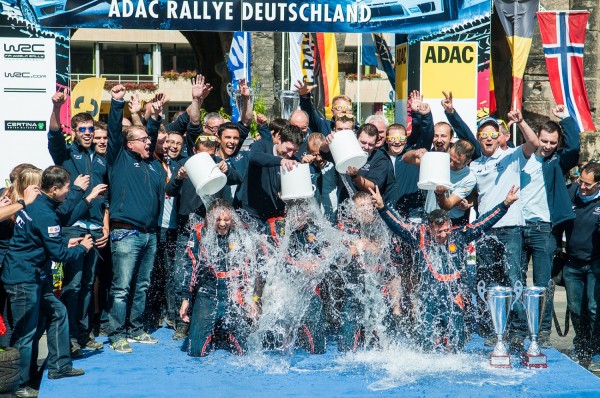Remember the Ice Bucket Challenge? It Raised $220 Million Leading to a Breakthrough in ALS Research
The Ice Bucket Challenge, a 2014 social media sensation that featured celebrities and other people dumping icy water on their head, was able to generate $220 million to raise awareness and support research for amyotrophic lateral sclerosis or ALS.
The funds generated were able to achieve a major breakthrough in ALS research. An experimental medication, although not a cure, was found to help slow down the progression of ALS.

At the ADAC Rallye Deutschland 2014, competitors take part in the ice bucket challenge.
FIND OUT MORE: American Loses 7 Relatives to COVID-19, Volunteers for Oxford Vaccine Trials
What is ALS?
Dr. Sabrina Paganoni works as a neuromuscular specialist at Massachusetts General Hospital's Sean M. Healey & AMG Center for ALS. She is also the lead author of the study and mentioned that the treatment focused on the two cellular structures damaged by the disease.
One is the mitochondria, which serves as the powerhouse of the cell, while the other one is the endoplasmic reticulum, which functions as the cellular dump trucks that are responsible for carrying away the waste that accumulates in the cells' machinery.
Amyotrophic lateral sclerosis (ALS), also known as Lou Gehrig's disease, is a progressive motor neuron disorder. It rapidly destroys the nerve cells or motor neurons that control muscle movement leading to disability.
According to The ALS Association, the prevalence of ALS at any given time in the Western countries is about one in 20,000 people. Usually occurring between the ages of 40 and 70, once the symptoms start, life expectancy decreases to about two to six years.
From an Ice Bucket to a Medical Breakthrough
The Ice Bucket Challenge was able to put ALS on the map and attract more investigators and investment to the research. The randomized, double-blind study is phase 2 of the trial. All drug approval required by the Food and Drug Administration needs to undergo a three-step process. In this double-blind study, neither patients nor the researchers will know who receives the drug. Once phase 2 generates positive results, the FDA will then require a larger and longer phase 3 trial.
The researchers observed 137 ALS patients who had become symptomatic within the last 18 months to test the effectiveness of the two-drug combination. Two-thirds of the patients (89) were administered the drug, while the rest were given a placebo.
These patients were then evaluated on a scale of 0 to 48 to measure the disabilities caused by the disease. By the time the trial ended, the baseline score was about 36 on average.
Although the trial revealed that there is no difference between medication and placebo in terms of time to death, tracheostomy, or permanent intubation, or hospitalization, Paganoni suspects that it may be because the trial only ran for six months.
Since the trial showed that the medication could make a difference, Paganoni hopes that if approved, this new drug would become part of the medication that can hold off ALS.
Because of the good news from the trial, ALS Association hopes to persuade the FDA to allow more access to the drug to other patients even before phase 3 trial results become available.
According to Paganoni, the goal of patients diagnosed with ALS is to retain their physical function for as long as possible. Since this experimental drug can slow down the progression of ALS, it can improve the quality of life of patients.
READ INTO: Scientists Test the Combination of Immunotherapies To Eliminate Solid Tumors
Check out more news and information on ALS and Neurology on MD News Daily.
Sep 03, 2020 09:41 PM EDT






